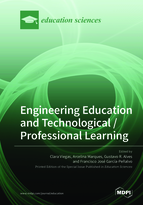Engineering Education and Technological / Professional Learning
A special issue of Education Sciences (ISSN 2227-7102).
Deadline for manuscript submissions: closed (31 August 2019) | Viewed by 55112
Special Issue Editors
Interests: engineering education; physics didactics; professional development; active learning; contextualized learning practices; students’ involvement in professional contexts; lifelong learning
Special Issues, Collections and Topics in MDPI journals
Interests: engineering education; remote labs; STEM education
Special Issues, Collections and Topics in MDPI journals
Interests: remote labs; online learning
Special Issues, Collections and Topics in MDPI journals
Interests: STEM; computational thinking
Special Issues, Collections and Topics in MDPI journals
Special Issue Information
Dear Colleagues,
The focus of this Special Issue is to enhance the discussion around Science and Engineering Education, and, in particular, technology and professional learning. This Special Issue is especially concerned with how student academic education prepares them for demanding professions. It is dedicated to openly discuss how young engineers are addressing these new challenges while adapting to their professional environments. How can they make a difference in the actual and demanding professional world? Which major difficulties do employers see in them? What do senior engineers seek and what is most value for a young professional? How can teachers and the academic background help students to stand out? In sum, what can we learn from these young professionals, from their employers, and from their teachers?
In the 21st century, students face a challenging demand: They are expected to have the best scientific expertise, but also highly-developed social skills and qualities like teamwork, creativity, communication and leadership. Even though students should be prepared over their academic education, there is still a gap between academic life and professional life. This gap might have several origins, namely students’ lack of maturity or intrinsic motivation to learn, excessive traditional classrooms practices, lack of opportunities for students to envisage contextualized professional practices, among others.
The purpose of this Special Issue is to help identify good practices and/or particular concerns that young engineers or their employees feel need improvement. In order to discuss this, different perspectives are welcome, including the viewpoint of young engineers, educators, tutors and employers. On the other hand, it would also be most helpful for freshmen students better understand what exactly is expected from them in the real world: What better than CEOs or former students’ thoughts to help students develop the needed intrinsic motivation to learn, solve problems, and become a true engineer?
Engineering education organizations have been addressing new professional challenges, guided by general concerns, such as teamwork abilities, argumentation and persuasion abilities in multiple social contexts, creativity, complexity handling, and leadership or strong work ethics. This stresses the importance of these competencies being worked through college along with communication, scientific/technological expertise, problem-solving or analytical/quantitative skills. Nowadays, it is as important to address scientific expertise as students’ social and professional competencies. Even though both are important, they do not play equal parts in students and teachers minds. Plus, the outcome perspectives from academic and professional worlds can be quite different. Thus, different point of views must be acknowledged and documented.
The need for a better understanding of engineering education in the 21st century is reflected in scientific research, where it is common to encounter big experiences, involving funding or school commitments. However, it is less common to encounter studies that can be applied by any goodwilling teacher. Smaller scaled studies representing better-contextualized teaching, closer to professional demands, can also bring valid insight to this discussion in the scientific community.
Dr. Clara Viegas
Dr. Arcelina Marques
Dr. Gustavo Alves
Dr. Francisco José García-Peñalvo
Guest Editors
Manuscript Submission Information
Manuscripts should be submitted online at www.mdpi.com by registering and logging in to this website. Once you are registered, click here to go to the submission form. Manuscripts can be submitted until the deadline. All submissions that pass pre-check are peer-reviewed. Accepted papers will be published continuously in the journal (as soon as accepted) and will be listed together on the special issue website. Research articles, review articles as well as short communications are invited. For planned papers, a title and short abstract (about 100 words) can be sent to the Editorial Office for announcement on this website.
Submitted manuscripts should not have been published previously, nor be under consideration for publication elsewhere (except conference proceedings papers). All manuscripts are thoroughly refereed through a double-blind peer-review process. A guide for authors and other relevant information for submission of manuscripts is available on the Instructions for Authors page. Education Sciences is an international peer-reviewed open access monthly journal published by MDPI.
Please visit the Instructions for Authors page before submitting a manuscript. The Article Processing Charge (APC) for publication in this open access journal is 1800 CHF (Swiss Francs). Submitted papers should be well formatted and use good English. Authors may use MDPI's English editing service prior to publication or during author revisions.
Keywords
- Engineering Education
- Engineering Internships
- Professional Contexts
- Soft Skills
- PBL
- Project Management
- Engineering Classroom Practices








